- News
- Reviews
- Bikes
- Accessories
- Accessories - misc
- Computer mounts
- Bags
- Bar ends
- Bike bags & cases
- Bottle cages
- Bottles
- Cameras
- Car racks
- Child seats
- Computers
- Glasses
- GPS units
- Helmets
- Lights - front
- Lights - rear
- Lights - sets
- Locks
- Mirrors
- Mudguards
- Racks
- Pumps & CO2 inflators
- Puncture kits
- Reflectives
- Smart watches
- Stands and racks
- Trailers
- Clothing
- Components
- Bar tape & grips
- Bottom brackets
- Brake & gear cables
- Brake & STI levers
- Brake pads & spares
- Brakes
- Cassettes & freewheels
- Chains
- Chainsets & chainrings
- Derailleurs - front
- Derailleurs - rear
- Forks
- Gear levers & shifters
- Groupsets
- Handlebars & extensions
- Headsets
- Hubs
- Inner tubes
- Pedals
- Quick releases & skewers
- Saddles
- Seatposts
- Stems
- Wheels
- Tyres
- Health, fitness and nutrition
- Tools and workshop
- Miscellaneous
- Tubeless valves
- Buyers Guides
- Features
- Forum
- Recommends
- Podcast
TECH NEWS
First ride: Cervélo P5
Ta-dah! Here it is, folks – the new P5 time trial bike from Cervélo which the Canadian brand reckons is the most aerodynamically advanced in the world.
According to Cervélo founder Phil White at the bike’s launch in Fuerteventura, the P5 features a completely new way of managing airflow and, compared to the P4 and everything else on the market, “It’s better all round.”
As well as a new frame and fork, if you buy the P5 as a complete bike you can get the new Aduro aerobar produced by 3T that’s also claimed to be the most aerodynamically advanced out there, new RT8 TT hydraulic rim brakes from Magura that are lighter and more powerful than anything else available, and redesigned storage and hydration systems. If those components aren’t for you, however, you can run standard parts instead.
The other big news is that Cervélo are launching the P5 in two different forms, one that’ll keep the UCI off their backs and a triathlon version that features elements that won’t get the UCI stamp of approval.
We’ve been lucky enough to ride the P5 on the roads of the Canary Islands and can tell you that this is one fast machine, but before we get to that, let’s look at the technology piece by piece…
Frameset

Cervélo have always spent loads of time in the wind tunnel, which makes a whole lot of sense for a brand that’s fanatical – some might say ‘obsessed’ – by aerodynamics. The trouble is, that costs them about $10,000 per day so they’ve invested somewhere between 12 and 18 months developing their own computational fluid dynamics (CFD) program that they’ve put to use designing the P5. It’s a virtual wind tunnel, if you like. So, rather than being designed in the wind tunnel, Cervélo are saying that the P5 is designed in CFD and validated in the wind tunnel.
Cervélo employ their own full-time aerodynamicist whose job is to look after this side of the development process. It takes about 2 ½ days to run each design through the computer once – and they have to do that at various yaw angles (apparent wind angles) to get an accurate portrayal of a bike’s aero performance.
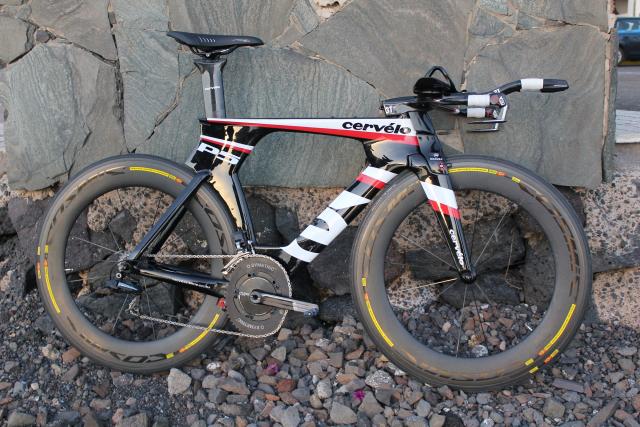
One of the key advantages CFD has is that whereas the wind tunnel just gives a drag figure, the computer is able to show the engineers what is happening around each element of the bike and rider. Phil White, who along with Gerard Vroomen founded Cervelo, puts a lot of the key design features of the P5 down to this improved picture and reckons they’ve come up with a bike that’s, “A significant step forward in terms of speed and simplicity. This bike isn’t just faster, it’s easier to live with.”
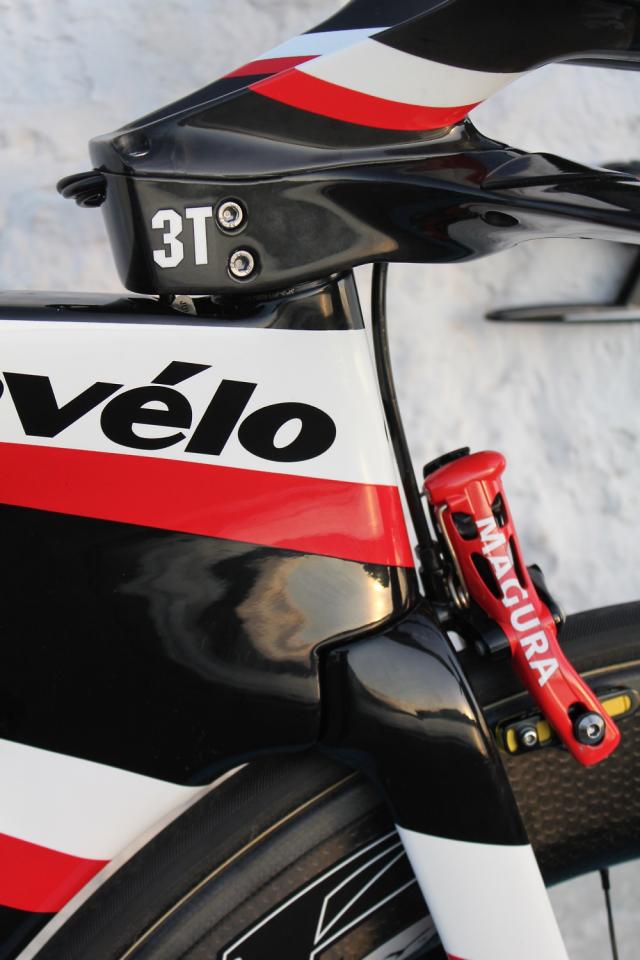
You couldn’t say there’s one over-arching aerodynamic approach that sums up the P5 because Cervélo have come up with different answers in different areas of the bike. The head tube, for example, is designed with the front brake in mind (more on that later). It’s super-deep while the triathlon version gets a shroud over the top of the brake and what Cervélo are calling a ‘beard’ to fill the gap between the stem and the upper section of the head tube.

The seat tube manages airflow over the rear wheel with varying shapes up and down its length, while the junction with the seat stays and the top tube produces another deep aerodynamic shell section with a lip at the front that’s designed to control the airflow in the rider’s wake. The ‘chord’ there – the depth of the tube profile in the area just south of the seat clamp – is almost twice as long as on the P4 for improved aerodynamics.
Cervélo have actually increased the width of the seat tube slightly to take account of the wider wheels and tyres that have become increasingly popular over the past couple of years, but they insist the drag of the bike with a rider on board has been reduced significantly here… and, after all, that’s what counts unless you’re thinking of sending your bike off to do a TT while you stay home.
The seatstays are widely spaced away from the rear wheel to deal with the aerodynamics back there while the down tube is positioned close behind the front wheel so it sits in its wake.

Up front, the fork comes in two different flavours, the UCI-legal version having sections that conform to the 3:1 tube restrictions. The triathlon one doesn’t have to bother with such stuff. We didn’t have the chance to take the road.cc ruler to it but those blades are deep. That’s a standard 1 1/8in steerer tucked away inside the head tube, though, so you can fit other forks in there and use any normal headset and stem.
What else can we tell you about the frame? The bottom bracket is Cervélo’s existing BBright standard and the cabling is 100% internal to minimise drag. The rear brake is tucked away behind the bottom bracket and it’s shrouded to smooth the airflow.
Oh, and if you want to run Shimano Di2, the battery lives inside the seat tube. You access a little pocket inside the cutout for the rear wheel. You have to remove the wheel to get at it.
Okay, that’s enough on the frameset. Let’s move on…
Aerobars

Although you can use any aerobars on the P5, a new set, called the Aduro, has been designed specifically for this bike in collaboration with 3T. Almost inevitably, Cervélo reckon this is, “Simply the fastest aerobar ever created.”
The Aduro comes with three height settings for the arm pad stack, then it’s micro-adjustable so you can get the precise fit you need. You can fine-tune all the variables: the arm rest width, their fore/aft position and the amount of extension via telescopic clamps… You also get to choose the extension shape.
The spacers are aero-matched to the stem and both the gear and brake cables are completely hidden internally; Cervélo’s figures say exposed cables can cause up to 40g of drag. It’s a really neat design and they manage to give you all that adjustability with very few different parts so the setup is nice and simple.
If you want to, you can run the Aduro with a very low stack so, although the P5 has a slightly longer head tube than the P4, you can get a similarly low front end height. It comes in a 38cm width only - which is narrow, although there's a significant drag saving over a wider bar.
The other interesting feature is that you can fit a standard bottle cage horizontally to these bars. Cervélo have long said that the most aerodynamically efficient position for carrying your drink is between your forearms. You can actually improve your aerodynamics by mounting a bottle up there. Here, you just fit a normal cage – one that you trust – and use a normal bottle.
The bars are compatible with both mechanical and hydraulic brakes and with mechanical and electronic shifting and they’ll be available to buy aftermarket.
Brakes
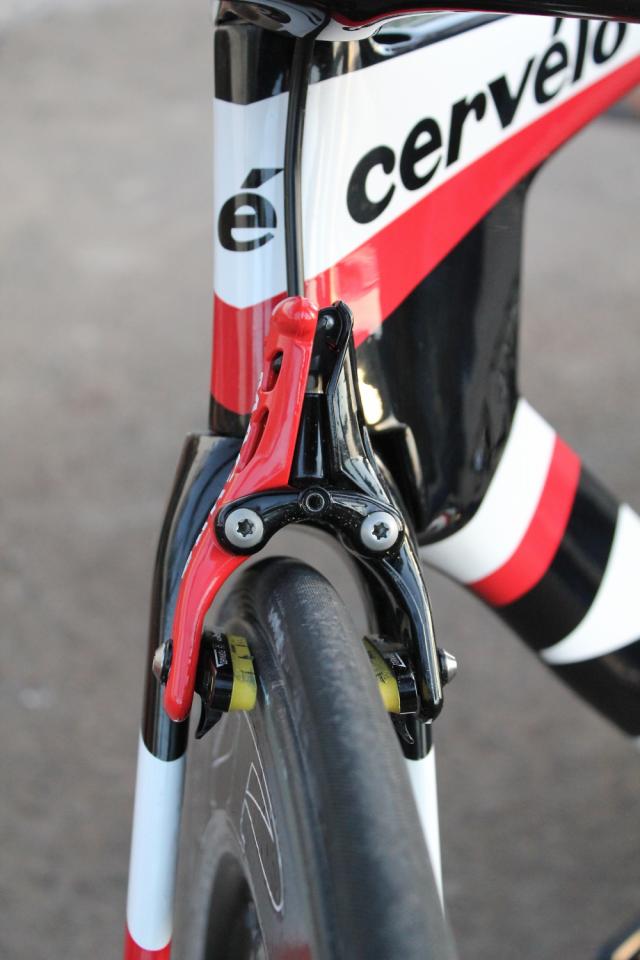
Ah, the brakes! Right, these are a brand spanking new hydraulic rim brakes from Magura. The German brand are huge in mountain biking but these have been designed especially for the P5. That said, the RT8 TTs will be available aftermarket through Cervélo dealers only until 31 May and on general release after that (£399 per pair with aluminium lever, £499 per pair with carbon lever) and you can fit any standard rim brakes to the P5 if you prefer.
So, what are the benefits of the RT8 TT? Cervélo and Magura list these:
• It’s aero-matched to the P5 frame – they work together to produce less drag
• It’s the lightest system out there at 495g for a complete front and rear system, including oil. Magura say that’s about 25g lighter than SRAM Red (although they didn’t mention it by name)
• It offers more power than anything else
• It offers more modulation than anything else
• It works with all wheels
• It’s a single bolt mounting – the same as standard callipers
• There’s no cable friction so it can perform perfectly even with complicated internal routing
So, there you go… better on all fronts, according to the manufacturers. Even when fitted to a bike other than the P5, Magura claim this is a super-aero design.
Essentially, there’s a piston between the two brake arms, above the pivots. Squeezing the lever means that the piston pushes the arms wider above the pivots so they push in below the pivots on to the rim. Geddit? It’s pretty straightforward. Clever, but straightforward.
Magura say that with a force of 100 Newtons, the RT8 TT will decelerate you and your bike at 6.4m/sec2. That probably doesn’t mean much to you although top end competitors are 4.3-4.5. In other words, you can have more powerful braking or brake at the same speed with less effort.
How does that help? Well, any saved energy has to be a good thing but, more important, it also means you can leave your braking later.
“With this brake you can stay faster for a longer time,” said Magura’s Product Manager Stefan Pahl. “You can brake at the last second.”
The RT8 TT uses universal cartridge brake pads so you’ll have no problems replacing them, and there’s a little quick release button on the lever which allows you to get wheels in and out easily.
Speaking of the lever, it comes with an ultra-light forged aluminium body and a full carbon blade (an alu version will be available) that’s airfoil shaped. It fits all handlebar diameters thanks to a clever little mount design. The master cylinder is hidden in the lever.
Magura say that the brakes require very little maintenance and they come with a five-year leakproof warranty. Bleeding them requires just standard Magura tools so any decent bike shop should be able to help you out there, and they use mineral oil.
Incidentally, Magura were keen to point out that even if they were permitted for road racing, disc brakes have weight disadvantages over a hydraulic rim design because you have to make the frame and fork stiffer. If you’re worried, these brakes are UCI approved.
If you want to know more about the brakes, they have their own microsite: fastest-brake-on-the-market.com.
Storage
The final aspect of the P5’s design that’s worth noting is the storage. You probably know that the P4 had a waterbottle integrated into the frame, nestling just above the bottom bracket. The UCI banned it and it turns out that loads of people used it for storing gels, inner tube and stuff, so Cervélo have had a rethink…
You can still buy a storage device aftermarket that sits in that area and I’ve already mentioned the bottle cage mount on the Aduro bars. I’ve also mentioned the little pocket hidden inside the wheel cutout for storing an electronic-shifting battery. Cervélo reckon that squirreling it away inside the frame saves 10-20g of aero drag. On top of that there are several alternative positions for fixing aftermarket storage and hydration.
You get standard bottle cage bosses on the down tube and you can also mount water bottles behind the saddle. You get bosses for fixing a Bento Box on the top tube, just behind the stem; that’s an ideal spot for gels and bars. If all that’s not enough… um, panniers? Maybe not.
The ride
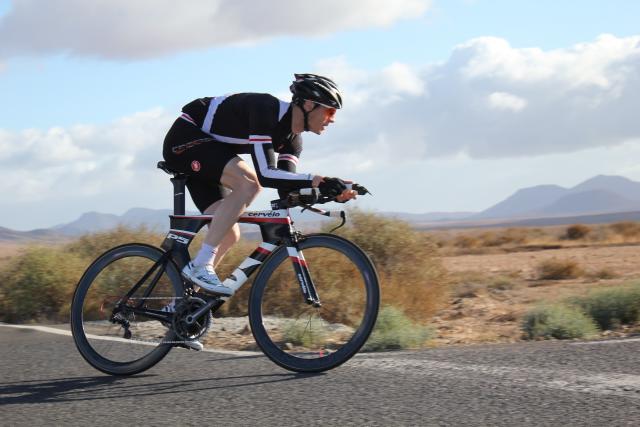
So, that’s the technology behind the P5 as given to us to by the guys from Cervélo and Magura out here at Playitas, Feurteventura (for all your warm-weather training needs). And, what’s more, I had the chance to climb on board and get out there on the road this morning. There are only a handful of these bikes in existence so far so I’ve been really lucky. I actually got to borrow the bike belonging to Caroline Steffen, a Swiss athlete who finished fifth in the Ironman World Champs in Hawaii last year.
First off, this bike is stiff (even Cervélo wheeled out the ‘laterally stiff, vertically compliant’ line, by the way. It’s nice to hear from an old friend when you’re so far from home). Fire your quads off the start line and there’s not even a hint of flex anywhere. You’d need a jack hammer to knock that massive bottom bracket area off line and the same goes for that head tube. It doesn’t matter what ammunition you have in your arsenal, it’s just not going to happen.
Those bars? It’s the same story. Get your hands on either end and heave for all you’re worth and everything stays right where it should be.
Of course, you’re not going to spend a great deal of your time wrestling with the front end as you ride out of the saddle on most TT or triathlon courses. You want to get into the saddle and hunkered down as much as possible and that’s when the P5 really shows its worth.
For a start, it’s comfortable enough. I wasn’t on the bike long enough to let you know for sure about all-day comfort but there’s plenty of adjustment here for you to set up a position that you’re happy with and there’s a reasonable amount of damping.
There are some really smooth roads out here and there are some British-style roads out here. Over the rough stuff the P5 was absolutely fine. Your saddle is going to come play a big part here but there’s no particular jarring, rattling or buzzing coming through the frame. It’s just… fine. And the gel pads are soft and cushioned without being ridiculously squishy so I I felt quite relaxed in the upper body even when the wheels were being bumped about.
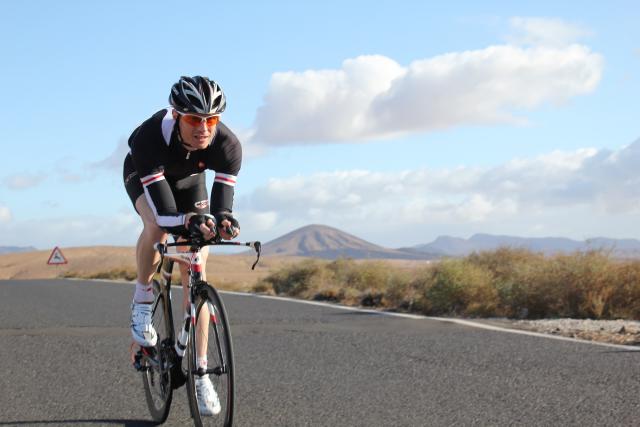
The P5 really scores when you get your head down and start turning a big gear. The faster you go, the better it is. Get a flat-ish, straight-ish section of road and you really fly. If the wind is coming at you, the bike seems to slip through relatively unnoticed and it’s not particularly bothered when the air is coming at a slight angle. It’s mega-windy here at the moment but I felt unflustered on some 50mm Campag wheels.
I mounted a 500ml (small) water bottle to the bars too and that worked well. The steering feels a little heavy to start with but you soon adjust. Be ready to hear a half-full bottle sloshing about as you go around corners, though.
Those hydraulic brakes really do live up to the promises that Magura make. You often don't need all that power. And in damp conditions, it's relatively easy to skid on skinny road tyres so you don't want to leave braking until the very last moment. But the thing is, with all that power at your fingertips, you do get a whole load of confidence. Knowing that you can stop at a moment's notice does mean that you do lay off the levers that little bit longer. You see a corner coming up and you're not sure if you need to brake or not. With less power at your disposal, you have to brake to be on the safe side. With these, you can get closer to that corner before you have to make that decision, and by which time you might see that, actually, you don't need to slow down after all... and that's money in the bank.
The P5 is at its absolute best when you have a slight descent and the opportunity to crank it up. Hit around 30mph, say, and it pings along much easier than should really be possible. Hot knife through butter? You betcha boots. I had a slight tailwind and a slight downhill and ran out of gears on a 53-11. It’s hard to judge on unfamiliar roads but I’m saying this bike is a bit special.
The Cervelo P5 will be available in two different versions. The triathlon frameset (with the deeper fork, the RT8 TT brakes, the cover over the front brake and the beard above that cover, and the Aduro aero bar) will be £4,499.99. The UCI-legal version will be £3,499.99.
UK distributor Madison reckon that limited stock will be available through authorised Cervélo dealers from May but you'll need to be quick off the mark to secure one that early because demand is high.
For additional info go to www.cervelo.com.
Mat has been in cycling media since 1996, on titles including BikeRadar, Total Bike, Total Mountain Bike, What Mountain Bike and Mountain Biking UK, and he has been editor of 220 Triathlon and Cycling Plus. Mat has been road.cc technical editor for over a decade, testing bikes, fettling the latest kit, and trying out the most up-to-the-minute clothing. He has won his category in Ironman UK 70.3 and finished on the podium in both marathons he has run. Mat is a Cambridge graduate who did a post-grad in magazine journalism, and he is a winner of the Cycling Media Award for Specialist Online Writer. Now over 50, he's riding road and gravel bikes most days for fun and fitness rather than training for competitions.
Latest Comments
- mdavidford 1 hour 9 min ago
If they "leave you in the dust", maybe you're better off without 'mates' like that in the first place.
- David9694 1 hour 52 min ago
This must be one of the many "I insist on using cash in the parking meter" articles, usually based on the person being old and infirm and unable to...
- Slartibartfast 2 hours 25 min ago
Might have to expand on this one a bit fella as it's hard to unpick exactly what your point is.
- hapaxlegomenon 5 hours 28 min ago
Caad12 / 13's don't have udh, which doesn't seem like a big deal right now. But wait for it
- mark1a 8 hours 14 min ago
Yep, my dad was a handler (wafu chockhead) in the Fleet Air Arm back in the 70s/80s/90s and he said the worst thing about when Top Gun came out in ...
- Sredlums 8 hours 53 min ago
"else much more people would get cancer" Err… what!? A huge amount of people DO get cancer 😑
- cmedred 12 hours 16 min ago
Do you think the moto addicts of BCP worried about what "right" cyclists "have to tell anyone what to do on the roads'' ever ponder what "right"...
- mark1a 12 hours 19 min ago
It's a little reminiscent of the S-Works Tarmac that Trinity Racing rode in 2023.
- Gkam84 12 hours 27 min ago
It's a shame it never really took off, I used to play a lot and for a few seasons was helping to run the back end. It was a really enjoyable one...








































Add new comment
27 comments
have you had the swag grab yet or did i miss it?
YES PLEASE I WOULD LIKE THIS BIKE.
not wishing to be picky, but you'd only be at an aero 'disadvantage' in a tailwind if the wind speed was greater than the speed you were travelling. Assuming you're moving faster than the air (which you are) and it's a true tailwind then your effective yaw is zero and the effective wind speed is lower, which means less drag since the higher drag, bluff frontal elements of the bike-rider combination which account for most of the drag will follow a roughly square-law increase in drag for a given increase in relative speed.
And anyway, i'd take the tailwind and screw the aerodynamics
"I had a slight tailwind and a slight downhill and ran out of gears on a 53-11"
Not wishing to be picky, but in a slight tailwind, actually you were disadvantaged as the greatest strengths of most "aero" bikes are generally when yaw angles are at or approach zero degrees, i.e. head-on, rather than 180 degrees (block tailwind).
The aero advantage relies on speed relative to airflow so 70 kmh downhill with 10kmh tailwind (if you were on 53 x 11 and spinning out at say 120 rpm, that'd be you approx road speed) is in aero terms about the same as 60kmh in still air or 50kmh in a 10kmh block headwind - having said all of which, even that isn't perfect as at 60 kmh your cadence would be around 105 rpm and at 50 kmh around 90 rpm (depending on exact tyre size and some odd decimals in the arithmetic) so the airflow over the rear 2/3 of the bike would be less disturbed.
When you start looking at yaw angles and have to take lift effects into account it all get a lot more complex.
Interesting that we looked at a lot of this stuff in the 1980s in the wind tunnel and with coast-down tests with a control and an actual rider ... the front 1/3 of the bike-rider combination (even without the legs spinning) appeared to make around 75% of the difference.
With the chain disconnected and the legs windmilling, we calculated about a 7% disadvantage relative to legs held still and presenting minimum frontal area (i.e. pedals at quarter-to-three).
Also interesting & supported by wind-tunnel data since is that female body shapes are more aero than male, esp when tribars are in use ...
Cervelo are pretty good at publishing their data so it'll be interesting to look in depth at what they do get out there re the P5.
The apparent wind is very much against you if you're riding fast with a slight tailwind behind you. The benefits of an aero bike are very real in this situation.
hi matt, could you ask the guy at magura to check his figures on the 6.4 m/s^2 of deceleration? As there was a very good brake article in 2009 which quoted shimano dura-ace 7800 brakes to have a deceleration of 9.58 m/s^2, did he mean 16?
As for the bike this looks amazing, can't wait for magura to bring out their hydralic di2 STI so everyone else can use the brakes!
Also the quote "works with all wheels" this could be a snipe at Ciamillo brakes (and similar styles) which are a single pivot brake with a lever cam to increase the power, they don't seem like wider rims like the new style zipp's and enve's.
No, 6.4m/sec2 with 100 Newtons of force on the lever. Magura aren't saying this is the maximum deceleration, it's the figure they got from their test with that amount of force.
ah my mistake, well cant wait to try them still
Itt is not as aerodynamic as the latest Ridley. I was lucky to be in my local bike shop when the rep came in to show it but would not let any of us ride it.
yes please....this is the weekly schwag isnt it?



Since the Magura levers are required for the calipers, this precludes the use of DI2 levers. If one wants shift levers on the base bar--can DI2 remote shifters be used instead?
there'll be an inline cable-fluid converter kit for brifters
That's true, roddw. Just to clarify for other people, with Shimano Di2, you can have multiple shift points: shifters on the extensions and shifters on the base bar. If you use the Magura brakes, you need to use Magura levers (unless you run the cable to hydraulic converter that's coming, but that won't help with Di2); you obviously can't use Shimano's Di2 shift/brake levers.
Cervélo say that you can't use Di2 satellite shifters on the Aduro bar. So if you go for the Magura RT8 TT brakes and the Aduro bar and you use Di2, the only shifting you can have is from the end of the aero extensions... for the time being, at least.
So I was contemplating a P4 a while ago, and decided against it because, when it all comes down to it, it is about looking good, and the P4 might be fast but is flat out ugly. This, though... If it is also as fast as it sounds I might have to start saving.
It'll be the 'tri tool' to have for most of the serious
iron man contenders. Shame chrissie wellington
won't be on one for a while.
A really interesting brake setup. I'm liking it a lot. Far more elegant that disc brakes. Isn't this as far as we need to go for road bikes?
Matt, how would these handle an alpine descent on a normal road bike? I imagine Thor or Nibali could make some serious time gaps leaving the braking so late. Obviously the weak link becomes the contact patch with the ground. Will better brakes mean tyre technology moves to keep pace?
As for the P5, it's a better looker than some recent TT models **cough** Giant Trinity **cough** Pinarello Graal **cough**
There's going to be a cable to fluid converter soon for use with standard road shifters.
As you say, the power of the brakes isn't the only factor involved in slowing. You don't want to skid and you don't want to brake so hard that you're pitched forward. But even taking those things into account, there's a significant advantage in increased braking power.
the technology in tyres moves on so quick i think this break set up that has caught up with tyres, however the price bracket is aimed at those who have top dollar or who are professional, and i think the answer to your alpine descent question is better than any other breaks.
Just out of interest, how much difference do the Rotor biopace-esque chainrings make?
Well, if you're running Shimano Di2 then you can't fit a small enough gear for the really steep stage of the Vuelta and you loose!
Less sarcastic answer: Wiggins, Froome and Thomas all swear by osymmetric rings.
So I guess that the fairings which cover the front brake and cable aren't UCI legal?
edit (having read article properly now): No they're not UCI legal.
Does it fly? It looks awesome and very expensive.
Are Magura/Cervelo really touting "It works with all wheels" as a benefit of the new brakes? Are there any road brakes that don't?
Other than that they look amazing; the weight is very impressive.
I think their point presumably relates to disc brakes
Ah, good point. Although i bet someone will be doing disc-only road rims soon enough.
Your wish is my command, cornelim. There should be one in the gallery now. You can't see a great deal because it's very neatly covered up.
That was quick, thanks! And you're right, they're covered up pretty good. But they have some decent info at the Magura microsite.
I'm severely tempted to put these on my C'dale Slice this summer. The colours would match perfectly.
Wow, looks very exciting. Out of my realm price-wise, of course. But I'm excited that the brakes will supposedly fit other bikes as well.
Why didn't you take a picture of the back brake?